SMD (Surface Mount Device) capacitors are crucial components in modern electronics, playing a vital role in storing and releasing electrical energy. Understanding the significance of capacitor sizes is paramount for engineers and hobbyists alike to ensure optimal performance and reliability of electronic circuits.
What are SMD Capacitors?
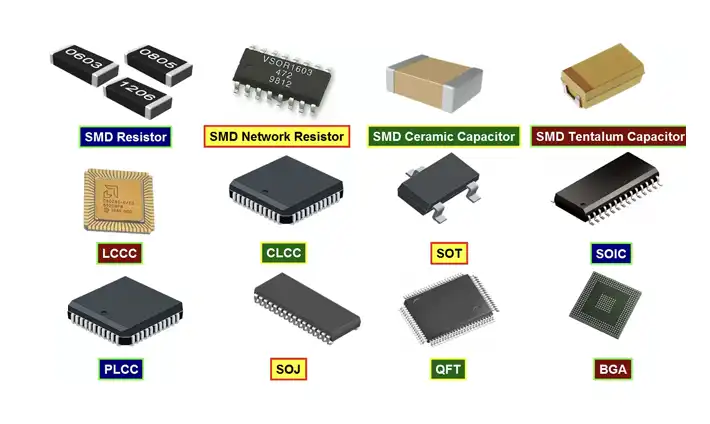
SMD capacitors, also known as surface mount capacitors, are compact devices used in printed circuit boards (PCBs) for various applications.
Unlike their through-hole counterparts, SMD capacitors are directly soldered onto the surface of the PCB, allowing for efficient use of space and improved manufacturability.
Importance of Capacitor Sizes
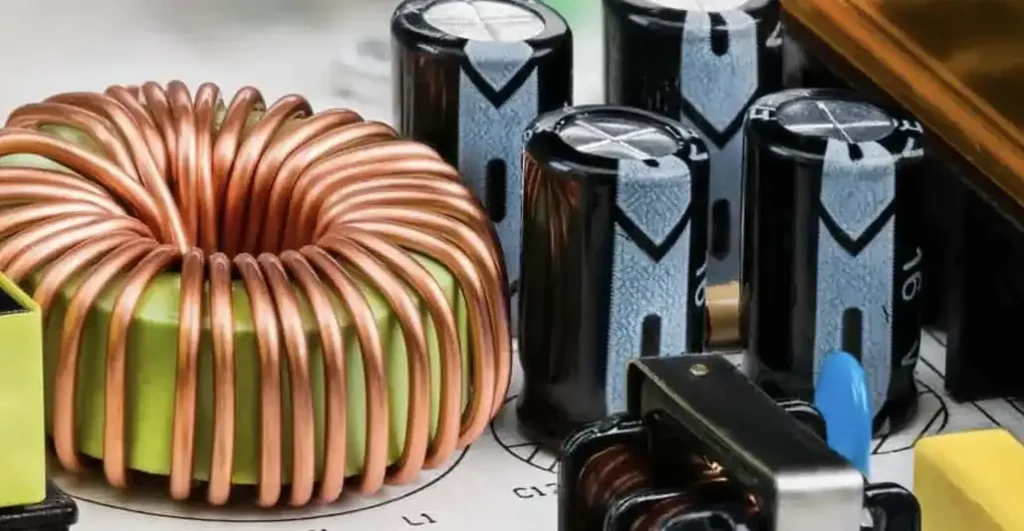
The importance of capacitor sizes lies in their direct influence on the performance and functionality of electronic circuits. Capacitors serve various critical functions in electronic devices, including energy storage, filtering, and voltage regulation. Here’s why capacitor sizes are significant:
- Electrical Characteristics: The physical size of a capacitor directly affects its electrical properties, such as capacitance and voltage rating. Capacitance determines the amount of charge a capacitor can store, while voltage rating indicates the maximum voltage the capacitor can withstand. Choosing the right size ensures that these electrical characteristics align with the requirements of the circuit.
- Space Constraints: In modern electronics, where miniaturization is key, space constraints are often a primary consideration. Capacitors must fit within the available space on printed circuit boards (PCBs) without overcrowding or interfering with other components. Optimal sizing allows for efficient use of space and enables compact and sleek device designs.
- Performance Optimization: Properly sized capacitors contribute to the overall performance optimization of electronic circuits. They help stabilize voltage levels, reduce noise, and improve signal integrity, ensuring reliable operation under varying load conditions. By selecting capacitors of the appropriate size, engineers can enhance the overall efficiency and functionality of their designs.
- Thermal Considerations: Capacitor sizes also impact thermal management within electronic systems. Larger capacitors typically dissipate heat more effectively due to their larger surface area, which can be beneficial in high-power applications. Proper thermal management ensures that capacitors operate within their specified temperature limits, preventing overheating and potential damage.
- Manufacturability and Assembly: Capacitor sizes influence the manufacturability and assembly process of PCBs. Smaller-sized capacitors facilitate automated assembly techniques such as pick-and-place, reducing manufacturing costs and improving production efficiency. Additionally, standardized capacitor sizes simplify inventory management and procurement processes for manufacturers.
In essence, capacitor sizes play a crucial role in determining the performance, reliability, and manufacturability of electronic devices. By carefully selecting and sizing capacitors according to the specific requirements of their applications, engineers can ensure optimal functionality and longevity of electronic circuits.
Types of SMD Capacitors
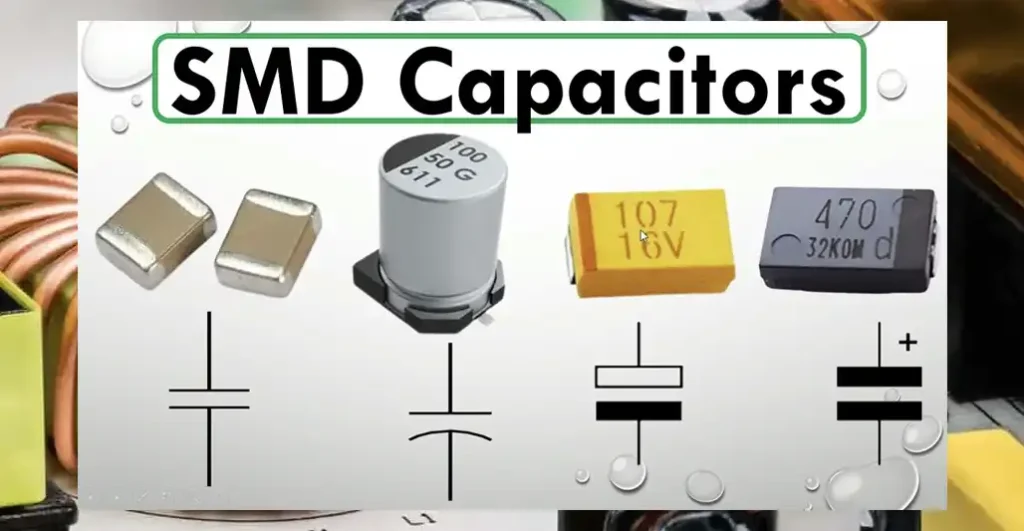
Ceramic Capacitors
Ceramic capacitors are among the most common types of SMD capacitors, prized for their small size, low cost, and wide range of capacitance values. They are suitable for high-frequency applications and come in various sizes, including 0402, 0603, 0805, and 1206.
Tantalum Capacitors
Tantalum capacitors offer high capacitance density and excellent stability, making them ideal for applications requiring high reliability and performance. Common sizes include A, B, and C cases, with each size corresponding to different dimensions and capacitance ratings.
Electrolytic Capacitors
Electrolytic capacitors are known for their high capacitance values and are often used in power supply circuits and audio applications. They come in different form factors, such as radial and axial, with varying diameters and lengths depending on the capacitance and voltage ratings.
There are many General High Voltage Capacitors. Here are the common industry names that people in the electronics industry must know.
The models used in combination include 4700uf 50v capacitor, 47uf capacitor, 471uf capacitor, 472uf capacitor, 473uf capacitor, high voltage capacitor, aluminum electrolytic capacitor, blown capacitor, filter capacitor, mica capacitor, 50 5 capacitor, 103 capacitor,fan capacitor,audio capacitor. microfarad capacitor.blown capacitor,filter capacitor ,mica capacitor
SMD Passive Component Sizes
SMD (Surface Mount Device) passive components come in a variety of sizes, typically denoted by a code representing their dimensions.1 Here are some common sizes:
- 01005: 0.4mm x 0.2mm – Extremely small, used in high-density applications.
- 0201: 0.6mm x 0.3mm – A common size for many applications.
- 0402: 1.0mm x 0.5mm – A popular and widely used size.
- 0603: 1.5mm x 0.8mm – A larger size, often used for higher power components.
- 0805: 2.0mm x 1.3mm – Another common size, offering a good balance of size and performance.
- 1206: 3.0mm x 1.5mm – A larger size for higher power or larger value components.
Note: These are just a few of the many SMD sizes available. Other sizes and custom packages are also available depending on specific requirements.
Here’s the table about SMD passive component sizes:
| Size Code | Dimensions (mm) |
|---|---|
| 01005 | 0.4 x 0.2 |
| 0201 | 0.6 x 0.3 |
| 0402 | 1.0 x 0.5 |
| 0603 | 1.5 x 0.8 |
| 0805 | 2.0 x 1.3 |
| 1206 | 3.0 x 1.5 |
The choice of SMD size depends on various factors, including:
- Space constraints: Smaller sizes are crucial for high-density PCBs.
- Power requirements: Larger sizes can handle higher power dissipation.
- Manufacturing considerations: Smaller sizes can be more challenging to handle and assemble.
- Component availability: The availability of components in different sizes can also influence the design choice.
By carefully selecting the appropriate SMD size, engineers can optimize the design of electronic circuits for size, performance, and cost-effectiveness.
Factors Influencing Capacitor Sizes
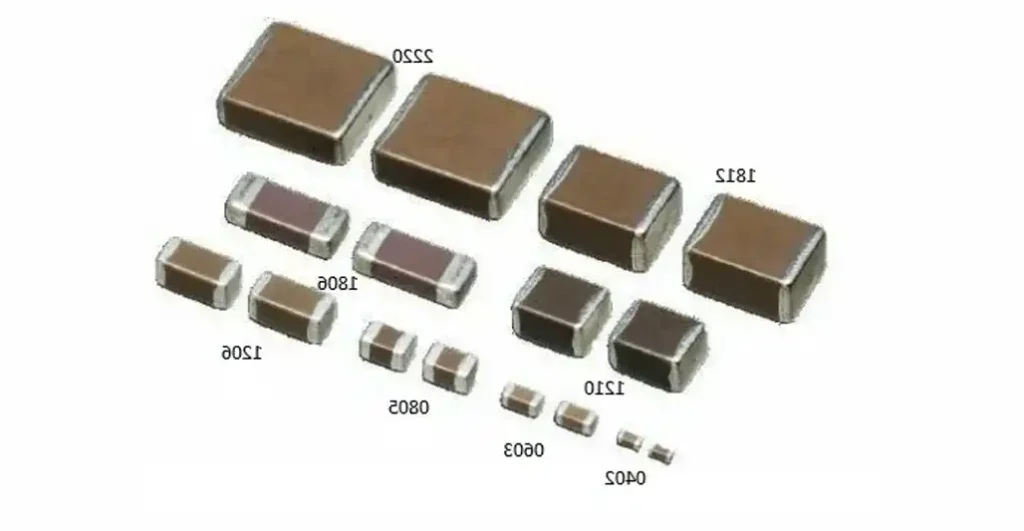
Voltage Rating
The voltage rating of a capacitor determines the maximum voltage it can withstand without risking damage. Higher voltage ratings typically result in larger capacitor sizes to accommodate thicker dielectric layers and electrode spacing.
Capacitance
Capacitance, measured in farads (F), indicates the amount of charge a capacitor can store per unit voltage. Larger capacitance values require physically larger capacitors to accommodate the necessary electrode area and dielectric thickness.
Package Size
The package size of an SMD capacitor refers to its dimensions, including length, width, and height. Smaller package sizes offer space-saving benefits but may have limitations in terms of maximum capacitance and voltage ratings.
Choosing the Right Size of Capacitors
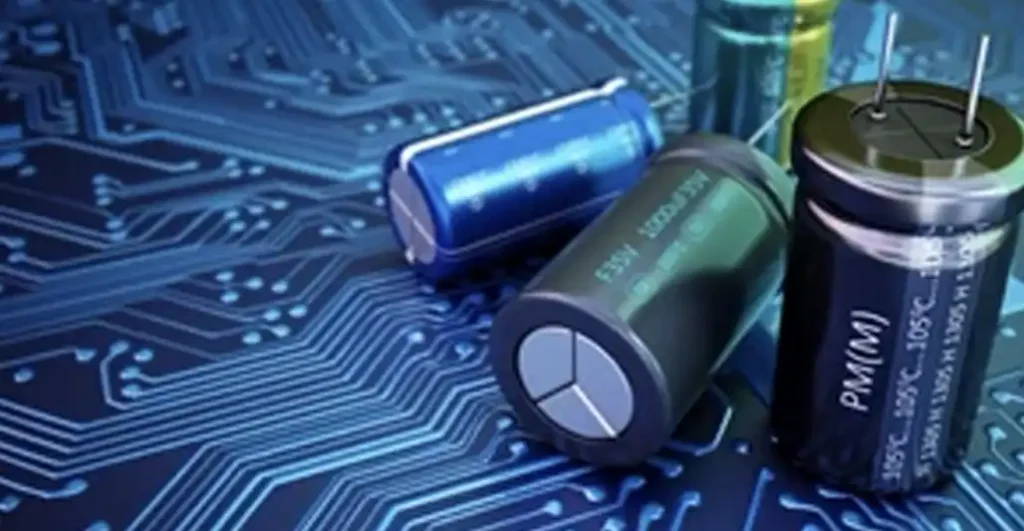
Choosing the right size of capacitors is a critical step in the design and implementation of electronic circuits. Capacitors come in various sizes, each with its own set of electrical characteristics and physical dimensions.
Here’s why selecting the appropriate capacitor size is essential:
- Electrical Requirements: Different electronic circuits have specific electrical requirements, including capacitance and voltage ratings. Capacitors must be sized accordingly to meet these requirements and ensure proper functionality. Choosing capacitors with the right capacitance value ensures sufficient energy storage and efficient filtering of electrical signals.
- Space Constraints: PCB layouts often have limited space, especially in compact electronic devices. Selecting capacitors that fit within the available space is crucial to avoid layout constraints and ensure proper assembly. Engineers must consider the physical dimensions of capacitors and their compatibility with the PCB layout to optimize space utilization.
- Frequency Response: Capacitor size can affect the frequency response of electronic circuits, particularly in high-frequency applications. Smaller capacitors typically have lower parasitic inductance and resistance, making them suitable for high-frequency operation. Engineers need to choose capacitor sizes that provide the desired frequency response while minimizing signal distortion.
- Voltage Rating: Capacitors must have adequate voltage ratings to withstand the maximum voltage levels present in the circuit. Choosing capacitors with insufficient voltage ratings can lead to capacitor failure or electrical breakdown, resulting in circuit malfunction or damage. Engineers must ensure that the selected capacitor sizes match or exceed the required voltage ratings for reliable operation.
- Temperature Considerations: Capacitor size can also impact thermal management within electronic systems. Larger capacitors dissipate heat more effectively due to their larger surface area, which can be beneficial in high-power applications or environments with elevated temperatures. Engineers should consider temperature effects when selecting capacitor sizes to prevent overheating and ensure long-term reliability.
- Application-Specific Requirements: Different applications may have unique requirements or constraints that influence capacitor size selection. For example, automotive or aerospace applications may require capacitors with specific size limitations or environmental ruggedness. Engineers must assess the application-specific factors and choose capacitor sizes that meet the necessary criteria for optimal performance and reliability.
Choosing the right size of capacitors involves considering various factors such as electrical requirements, space constraints, frequency response, voltage ratings, temperature considerations, and application-specific requirements. By carefully evaluating these factors and selecting capacitors that align with the needs of the electronic circuit, engineers can ensure optimal functionality, reliability, and performance.
Benefits of Proper Sizing
Proper sizing of capacitors offers numerous benefits, contributing to the overall performance, reliability, and efficiency of electronic circuits. Here are some key advantages of selecting the right capacitor size:
Optimized Performance: Properly sized capacitors ensure that electronic circuits operate within their designed specifications, resulting in optimized performance. Capacitors with the correct capacitance value and voltage rating effectively store and release electrical energy, facilitating smooth signal transmission, voltage regulation, and filtering. This optimization leads to improved circuit efficiency and functionality.
Enhanced Stability: Capacitors play a crucial role in stabilizing voltage levels and reducing electrical noise within circuits. By choosing capacitors of the appropriate size, engineers can minimize voltage fluctuations, ripple, and transient responses, thereby enhancing circuit stability. This stability is essential for maintaining consistent operation and preventing signal distortion or interference.
Improved Reliability: Properly sized capacitors contribute to the overall reliability and longevity of electronic systems. Capacitors that match the requirements of the application experience minimal stress and degradation over time, reducing the likelihood of premature failure or malfunction. Enhanced reliability ensures uninterrupted operation and minimizes the need for costly repairs or replacements, especially in critical applications.
Efficient Space Utilization: Selecting capacitors that fit within the available space on printed circuit boards (PCBs) allows for efficient space utilization. Properly sized capacitors help optimize PCB layouts, minimize component overcrowding, and facilitate streamlined assembly processes. This efficient use of space enables the design of compact and lightweight electronic devices without compromising performance or functionality.
Cost Savings: By choosing the right capacitor size, engineers can avoid unnecessary expenses associated with over-specification or under-specification of components. Properly sized capacitors meet the specific requirements of the application without overspending on larger or higher-rated capacitors than necessary. This cost-effective approach reduces material costs and improves overall project profitability.
Compatibility and Interoperability: Capacitors that are correctly sized and selected ensure compatibility and interoperability with other components within the electronic system. Proper sizing prevents impedance mismatches, signal distortion, or compatibility issues that could arise from using capacitors with inappropriate electrical characteristics or physical dimensions. This compatibility enhances system reliability and facilitates seamless integration with other subsystems or devices.
SMD Capacitor Capacitance
SMD Capacitor Size Chart
Below is the SMD capacitor size chart for the most common type of SMD capacitor: multilayer ceramic SMD capacitors, or MLCCs.
| Size Code | Dimensions (mm) | Imperial Equivalent |
|---|---|---|
| 01005 | 0.4 x 0.2 | 0.016″ x 0.008″ |
| 0201 | 0.6 x 0.3 | 0.024″ x 0.012″ |
| 0402 | 1.0 x 0.5 | 0.040″ x 0.020″ |
| 0603 | 1.6 x 0.8 | 0.063″ x 0.031″ |
| 0805 | 2.0 x 1.25 | 0.079″ x 0.049″ |
| 1206 | 3.2 x 1.6 | 0.126″ x 0.063″ |
| 1210 | 3.2 x 2.5 | 0.126″ x 0.098″ |
| 1812 | 4.5 x 3.2 | 0.177″ x 0.126″ |
| 1825 | 4.5 x 6.4 | 0.177″ x 0.252″ |
| 2220 | 5.7 x 5.0 | 0.224″ x 0.197″ |
These size codes represent the dimensions of the SMD capacitors in metric units (millimeters) and their equivalent dimensions in imperial units (inches). It’s essential to refer to this chart when selecting SMD capacitors to ensure compatibility with the PCB layout and assembly process.
SMD Capacitor Package Sizes
SMD capacitors come in various package sizes, each with its own set of dimensions and specifications. Here are some common SMD capacitor package sizes:
- 01005: This package size measures approximately 0.4mm x 0.2mm.
- 0201: With dimensions of around 0.6mm x 0.3mm, this package size is slightly larger than 01005.
- 0402: Measuring approximately 1.0mm x 0.5mm, the 0402 package size offers a compact yet manageable size for many applications.
- 0603: This package size is slightly larger, with dimensions of about 1.6mm x 0.8mm, providing more space for components.
- 0805: With dimensions of around 2.0mm x 1.25mm, the 0805 package size offers a good balance between size and accessibility.
- 1206: Measuring approximately 3.2mm x 1.6mm, the 1206 package size is commonly used in various electronic devices and circuits.
- 1210: This package size is similar to 1206 but slightly larger, with dimensions of about 3.2mm x 2.5mm.
- 1812: With dimensions of around 4.5mm x 3.2mm, the 1812 package size provides ample space for capacitors in larger electronic assemblies.
- 1825: Measuring approximately 4.5mm x 6.4mm, the 1825 package size is suitable for applications requiring larger capacitors.
- 2220: This package size offers even more space, with dimensions of about 5.7mm x 5.0mm, making it suitable for high-capacitance applications.
These package sizes provide options for engineers and designers to choose the most suitable capacitor size for their specific application requirements, taking into account factors such as space constraints, capacitance, voltage rating, and frequency response.
Here’s the information presented in a table format:
| Package Size | Dimensions (mm) | Dimensions (inches) |
|---|---|---|
| 01005 | 0.4 x 0.2 | 0.016″ x 0.008″ |
| 0201 | 0.6 x 0.3 | 0.024″ x 0.012″ |
| 0402 | 1.0 x 0.5 | 0.040″ x 0.020″ |
| 0603 | 1.6 x 0.8 | 0.063″ x 0.031″ |
| 0805 | 2.0 x 1.25 | 0.079″ x 0.049″ |
| 1206 | 3.2 x 1.6 | 0.126″ x 0.063″ |
| 1210 | 3.2 x 2.5 | 0.126″ x 0.098″ |
| 1812 | 4.5 x 3.2 | 0.177″ x 0.126″ |
| 1825 | 4.5 x 6.4 | 0.177″ x 0.252″ |
| 2220 | 5.7 x 5.0 | 0.224″ x 0.197″ |
This table provides a concise overview of the package sizes of SMD capacitors, including their dimensions in both metric (millimeters) and imperial (inches) units.
SMD Electrolytic Capacitor Size Codes
SMD electrolytic capacitors typically use different size coding compared to multilayer ceramic capacitors (MLCCs). Here are some common size codes for SMD electrolytic capacitors:
| Size Code | Dimensions (mm) | Imperial Equivalent |
|---|---|---|
| A | 6.3 x 5.4 | 0.248″ x 0.213″ |
| B | 7.3 x 4.3 | 0.287″ x 0.169″ |
| C | 7.3 x 7.3 | 0.287″ x 0.287″ |
| D | 8.0 x 6.3 | 0.315″ x 0.248″ |
| E | 8.0 x 8.0 | 0.315″ x 0.315″ |
| F | 10.0 x 7.3 | 0.394″ x 0.287″ |
| G | 10.0 x 10.0 | 0.394″ x 0.394″ |
| H | 12.5 x 13.5 | 0.492″ x 0.531″ |
| I | 12.5 x 21.5 | 0.492″ x 0.846″ |
| J | 16.0 x 10.0 | 0.630″ x 0.394″ |
These size codes indicate the dimensions of SMD electrolytic capacitors in millimeters and their corresponding imperial measurements in inches. It’s important to refer to this chart when selecting SMD electrolytic capacitors to ensure compatibility with the PCB layout and assembly process.
SMD Tantalum Capacitor Size Charts
SMD tantalum capacitors also use specific size codes to denote their dimensions. Here are the size charts for SMD tantalum capacitors:
Case Size (Metric)
| Size Code | Dimensions (mm) | Imperial Equivalent |
|---|---|---|
| A | 2.5 x 1.2 | 0.098″ x 0.047″ |
| B | 3.2 x 1.6 | 0.126″ x 0.063″ |
| C | 3.5 x 2.8 | 0.138″ x 0.110″ |
| D | 5.0 x 2.5 | 0.197″ x 0.098″ |
| E | 6.0 x 2.5 | 0.236″ x 0.098″ |
| F | 7.3 x 4.3 | 0.287″ x 0.169″ |
| G | 7.3 x 4.3 | 0.287″ x 0.169″ |
| H | 10.0 x 5.0 | 0.394″ x 0.197″ |
| I | 10.0 x 7.3 | 0.394″ x 0.287″ |
| J | 13.5 x 6.0 | 0.531″ x 0.236″ |
Case Size (Inches)
| Size Code | Dimensions (inches) | Metric Equivalent |
|---|---|---|
| A | 0.098″ x 0.047″ | 2.5 x 1.2 mm |
| B | 0.126″ x 0.063″ | 3.2 x 1.6 mm |
| C | 0.138″ x 0.110″ | 3.5 x 2.8 mm |
| D | 0.197″ x 0.098″ | 5.0 x 2.5 mm |
| E | 0.236″ x 0.098″ | 6.0 x 2.5 mm |
| F | 0.287″ x 0.169″ | 7.3 x 4.3 mm |
| G | 0.287″ x 0.169″ | 7.3 x 4.3 mm |
| H | 0.394″ x 0.197″ | 10.0 x 5.0 mm |
| I | 0.394″ x 0.287″ | 10.0 x 7.3 mm |
| J | 0.531″ x 0.236″ | 13.5 x 6.0 mm |
These size codes provide the dimensions of SMD tantalum capacitors in both metric units (millimeters) and imperial units (inches). Engineers should refer to these charts when selecting SMD tantalum capacitors to ensure compatibility with their PCB layout and assembly process.
Smd Ceramic Capacitor Size Chart
Here’s a chart illustrating SMD ceramic capacitor sizes and dimensions for SMD ceramic capacitors:
| Size Code | Dimensions (mm) | Dimensions (inches) |
|---|---|---|
| 01005 | 0.4 x 0.2 | 0.016″ x 0.008″ |
| 0201 | 0.6 x 0.3 | 0.024″ x 0.012″ |
| 0402 | 1.0 x 0.5 | 0.040″ x 0.020″ |
| 0603 | 1.6 x 0.8 | 0.063″ x 0.031″ |
| 0805 | 2.0 x 1.25 | 0.079″ x 0.049″ |
| 1206 | 3.2 x 1.6 | 0.126″ x 0.063″ |
| 1210 | 3.2 x 2.5 | 0.126″ x 0.098″ |
| 1812 | 4.5 x 3.2 | 0.177″ x 0.126″ |
| 1825 | 4.5 x 6.4 | 0.177″ x 0.252″ |
| 2220 | 5.7 x 5.0 | 0.224″ x 0.197″ |
This chart provides an easy reference for the size codes and dimensions of SMD ceramic capacitors. The dimensions are given in both metric (millimeters) and imperial (inches) units for convenience.
Common FAQs
What do SMD capacitor sizes signify?
SMD capacitor sizes indicate the physical dimensions of the capacitor, including length, width, and height. These sizes are standardized and help engineers and hobbyists select capacitors that fit their specific application requirements.
How to identify the correct capacitor size?
Identifying the correct capacitor size involves considering factors such as voltage rating, capacitance value, and package dimensions. Engineers often consult datasheets provided by capacitor manufacturers, which contain detailed information about the capacitor’s specifications.
Can I use a larger capacitor than specified?
In some cases, using a larger capacitor than specified may be acceptable, especially if space allows. However, it’s essential to ensure that the larger capacitor meets or exceeds the voltage and capacitance requirements of the circuit to prevent performance issues or damage.
What happens if I use a smaller capacitor?
Using a smaller capacitor than specified may result in insufficient energy storage or voltage regulation, leading to performance degradation or circuit malfunction. It’s crucial to match the capacitor size to the application’s requirements to avoid such issues.
Are there standard sizes for SMD capacitors?
Yes, there are standard sizes for SMD capacitors, typically designated by numerical codes such as 0402, 0603, 0805, and 1206. These codes correspond to specific dimensions, making it easier for engineers to select capacitors based on their space constraints and application needs.
How does temperature affect capacitor size?
Temperature can affect the electrical characteristics of capacitors, including capacitance and leakage current. Capacitors may experience changes in capacitance with temperature variations, leading to performance variations in electronic circuits. It’s essential to consider temperature effects when selecting capacitors for critical applications.
Conclusion
Choosing the right SMD capacitor size is paramount for ensuring optimal performance, reliability, and longevity of electronic circuits. By considering factors such as voltage rating, capacitance, and package size, engineers can select capacitors that meet the specific requirements of their applications, ultimately contributing to the success of their designs.